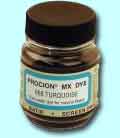advertisements
Procion MX Fiber Reactive Dye

The right way to dissolve dyes is called "pasting"; it is much like mixing cornstarch with water before using it to make gravy. Mix a very small amount of water with your dye and stir it until it forms a smooth paste. Gradually add more water, stirring until smooth, and only then mix in the rest of the water.
Fuchsia (Procion type red MX-8B) is the most common cause of this complaint. Dyers will see little red dots on their fabric, or orange spots in their "Bright Yellow" fabric, red dots in the "Midnight Blue", etc. Because bad batches of fuchsia cause so much trouble, I often prefer to use red MX-5B, known by the names of magenta, mixing red, or light red, instead of fuchsia, for this and other reasons. The colors are quite similar, but red MX-5B is better-behaved.
The real problem comes if you are buying premixed colors. Buying premixed colors can save you time and trouble, especially when you need a neutral black or grey color. However, dye suppliers often use fuchsia (red MX-8B) in mixing their fiber reactive dye colors.
You will not have any problems with the red spots caused by fuchsia (red MX-8B) if you buy only unmixed single-hue dye colors, other than fuchsia, and use them to mix your own colors. There are about twenty of these. To see which dye colors are unmixed, and which mixtures, see my table on Which Procion MX colors are pure, and which mixtures? (follow the link).
Dharma Trading Company advises users of their Procion MX fiber reactive dyes who wish to avoid the red spot problem to filter their dye solutions, that is, their mixtures of dye and water, with or without urea, using either a coffee filter or a piece of nylon stocking in a funnel or strainer. This usually works, though it's certainly more trouble. Unfortunately, if a dye mixture was prepared with a particularly bad batch of dye, even this may not always work, as occasionally dye particles can precipitate right back out of solution. If you are working on a project which will be ruined by little red dots all over it, it is important to test your mixed dye powders very soon after you buy them to see whether or not this is a big problem with any jar of dye you receive. If it is, you can return the dye for a refund, for being of inadequate quality, without first ruining a large amount of fabric or clothing. (You can never get a refund on the materials that you have dyed.) You usually cannot return dye for quality control issues more than thirty days after you order it, so be prompt in running any tests.
I'm not sure, but suspect that older batches of dye might also show more problems with the fuchsia dye they contain. Note that Dharma Trading Company advises the use of their Procion MX typedyes within one year of purchase, and PRO Chemical & Dye says their Procion MX type dyes should be good for up to two years.
Advertisements
 see answers to other FAQs about dyes and dyeing
see answers to other FAQs about dyes and dyeing
Page created: February 16, 2003
Last updated: July 25, 2006
Downloaded: Friday, December 05, 2025
All of the pages on this site are copyright ©1998‑2025 Paula E. Burch, Ph.D.